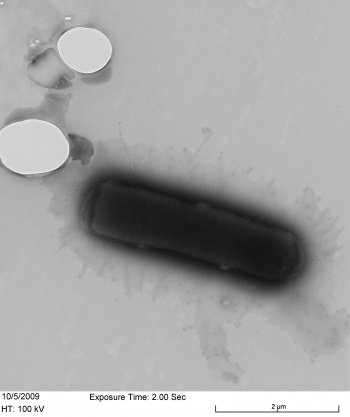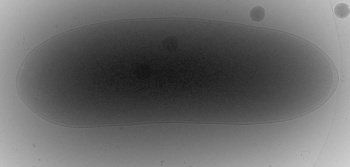Escherichia coli
General information about Escherichia coli.
Contents
General Information
- Escherichia coli is a rod-shaped bacterium. Each bacterium measures approximately 0.5 μm in width by 2 μm in length. E. coli is a Gram-negative bacterium. E. coli cells stain Gram negative because they have a thin cell wall with only 1 to 2 layers of peptidoglycan. E. coli is a facultative anaerobe, which means it does not require oxygen, but grows better in the presence of oxygen.
- Much like "breeds" of dogs, there are "strains" of Escherichia coli. Many strains of E. coli are harmless and are important to good digestive health since they reside in the large intestine and provide their hosts with vitamin K.[1][2] Other strains, which are referred to as pathogenic strains, are harmful and produce toxins.
- EcoliWiki is a resource for laboratory E. coli, which include non-pathogenic strains.
- Information from the Centers for Disease Control and Prevention about pathogenic and non-pathogenic E. coli
- Information about pathogenic E. coli in water sources from the Environmental Protection Agency (EPA)
- Information about pathogenic E. coli from the U.S. Food & Drug Administration (FDA)
- Information about research being performed on E. coli from the National Institute of Allergy and Infectious Diseases
Taxonomy
E. coli is a member of the:
- Bacteria;
- Proteobacteria;
- Gammaproteobacteria;
- Enterobacteriales;
- Enterobacteriaceae;
- Escherichia.
- Enterobacteriaceae;
- Enterobacteriales;
- Gammaproteobacteria;
- Proteobacteria;
Major subgroups
E. coli strains fall into five major taxonomic lineages (A, B1, B2, D, and E; ) [3]. In addition, species in the genus Shigella group within the E. coli groupings and different Shigella species have different E. coli groups as their closest relatives. E. coli K-12 strains are in subgroup A. Different methods for producing phylogenies provide different insights into the evolution of E. coli as a group[4][5].
NCBI Taxonomy
E. coli at NCBI taxonomy encompasses a large number of strains with different taxonomy IDs.
As of January 2010, the groupings in the NCBI taxonomy do not reflect the major groupings of E. coli and Shigella strains.
Laboratory E. coli strains
For more on why we study nonpathogenic laboratory E. coli, see E. coli as a model organism
See Category:Strain:E. coli and Category:Strains
Major E. coli lab strains used for basic research are mostly derived from E. coli K-12 and E. coli B.
E. coli K-12
Note that correct usage is K-12, not K12. E. coli K-12 is not serotype K. Escherichia coli K-12 was isolated in the fall of 1922 from the stool sample of a diptheria patient in Palo Atlo, California. The use of E. coli K-12 as a model organism for research was by sheer luck as E.L. Tatum received a culture of K-12 along with other species of bacteria for his biochemical genetic research. E. coli K-12 is prototrophic, easy to cultivate and its short generation time makes it easy to study in large populations.
E. coli B
E.coli B is the clonal descendant of a Bacillus coli strain from the Istitut Pasteur in Paris used by d'Herelle in his early studies of bacteriophages .Daegelen [6] examined the literature to derive what is known about the geneology of E. coli B strains. Current E. coli B strains are derived from the E. coli used in the phage studies of the Luria, Delbruck, and Hershey groups associated with the Cold Spring Harbor Phage community. Strain E.coli B is the common host for phages T1-T7 which led to the widspread use of B along with E. coli K-12.
E. coli C
Lieb et al. [7] describe differences between E. coli C, B, and K-12 in their study of hybrids between different E. coli strains.
E. coli W
E. coli Crookes
Morphology


Types
E. coli types are based on major surface antigens[8]
- O-antigen: the O antigen is part of the lipopolysaccharide. O antigens were originally defined by reaction with antisera from rabbits immunized with boiled bacteria. Hundreds of O groups have been identified.
- H-antigen: H antigen is flagellin
- K-antigens: K antigens were named for capsule (Kapsel in German). Sera subdivide K antigens into L, B, and A groups. At the molecular level, there are two major kinds of K antigens
- polysaccharide K antigens
- protein K antigens, mostly fimbriae
- R-antigen:
<protect>
| Strains | O antigen | H antigen | K antigen | Notes |
|---|---|---|---|---|
|
K-12 |
O16 (mutant) |
K-12 is phenotypically rough | ||
|
B |
||||
|
C |
| |||
| edit table |
</protect>
Chemical Composition
From Neidhardt[10] based on B/r. <protect>
| Component | %total dry weight | Amount (fg/cell) | Mol. wt | Molecules/cell | N. of kinds |
|---|---|---|---|---|---|
|
Protein |
55.0 |
156 |
4 x 104 |
2,350,000 |
1,850 |
|
RNA |
20.5 |
58 |
|||
|
23S rRNA |
31.0 |
1.0 x 106 |
18,700 |
1 | |
|
16S rRNA |
15.5 |
5.0 x 105 |
18,700 |
1 | |
|
5S rRNA |
1.2 |
3.9 x 104 |
18,700 |
1 | |
|
tRNA |
8.2 |
2.5 x 104 |
198,000 |
60 | |
|
mRNA |
2.3 |
1 x 106 |
1,380 |
600 | |
|
DNA |
3.1 |
8.8 |
2.5 x 109 |
2.1 |
1 |
|
Lipid |
9.1 |
25.9 |
705 |
22,000,000 |
|
|
Lipopolysaccharide |
3.4 |
9.7 |
4,070 |
1,430,000 |
|
|
Peptidoglycan |
2.5 |
7.1 |
(904)n |
1 |
1 |
|
Glycogen |
2.5 |
7.1 |
1 x 106 |
4,300 |
1 |
|
Polyamines |
0.4 |
1.1 |
|||
|
Putrescine |
0.83 |
88 |
5,600,000 |
1 | |
|
Spermidine |
0.27 |
145 |
1,100,000 |
1 | |
|
Metabolites, cofactors, ions |
3.5 |
9.9 |
800+ | ||
| edit table |
</protect>
Metal Content
<protect>
| Metal | Growth medium | Intracellular conc. | Conc. in medium | Method | Reference | Notes |
|---|---|---|---|---|---|---|
|
Mg12 |
LB |
|||||
|
Mg12 |
Minimal |
|||||
|
K19 |
LB |
|||||
|
K19 |
Minimal |
|||||
|
Ca20 |
LB |
|||||
|
Ca20 |
Minimal |
|||||
|
V23 |
LB |
|||||
|
V23 |
Minimal |
|||||
|
Cr24 |
LB |
|||||
|
Cr24 |
Minimal |
|||||
|
Co27 |
Minimal |
|||||
|
Ni28 |
LB |
|||||
|
Mn25 |
LB |
|||||
|
Ni28 |
Minimal |
|||||
|
Cu29 |
LB |
|||||
|
Fe26 |
LB |
|||||
|
Cu29 |
Minimal |
|||||
|
Fe26 |
Minimal |
|||||
|
Zn30 |
LB |
|||||
|
Co27 |
LB |
|||||
|
Zn30 |
Minimal |
|||||
|
Mn25 |
Minimal |
|||||
|
Se34 |
LB |
|||||
|
Se34 |
Minimal |
|||||
|
Mo42 |
LB |
|||||
|
Mo42 |
Minimal |
|||||
|
Mg12 |
GGM minimal |
24.2 mg liter-1 |
ICP-AES |
|||
|
Ca20 |
GGM minimal |
2.83 mg liter-1 |
ICP-AES |
|||
|
Mo42 |
GGM minimal |
0.068 mg liter-1 |
ICP-AES |
|||
|
Co27 |
GGM minimal |
0.018 mg liter-1 |
ICP-AES |
|||
|
Cu29 |
GGM minimal |
0.033 mg liter-1 |
ICP-AES |
|||
|
Fe26 |
GGM minimal |
0.886 mg liter-1 |
ICP-AES |
|||
|
Zn30 |
GGM minimal |
0.340 mg liter-1 |
ICP-AES |
| ||
| edit table |
</protect>
Pangenome
The pangenome is the nonredundant set of all genes found in all strains of a bacterial species. Based on analysis of 61 E. coli genomes, Lukjancenko et al.[13] identified 15,741 gene families in the E. coli pangenome.
Educational Resources
- EcoliWiki & Education
- Education links on EcoliWiki
- EcoliWiki Methods
- ASM CUE
- National Science Teachers Association
- National Association of Biology Teachers
Other E. coli Sequencing Projects
There are roughly 200 completed or ongoing sequencing projects for strains of E. coli. While this list continues to grow, some are listed here on EcoliWiki and NCBI has a complete list.
See also
- PortEco
- EcoCyc
- Stanford Microarray Database
- EcoSal (subscription required)
- E. coli at Wikipedia
- Gene lists for E. coli genomes in EcoliWiki
- CGSC - The Coli Genetic Stock Center
- Escherichia in Rod Welch's online textbook, the Prokaryotes .
References
See Help:References for how to manage references in EcoliWiki.
- ↑ Cummings, JH & Macfarlane, GT () Role of intestinal bacteria in nutrient metabolism. JPEN J Parenter Enteral Nutr 21 357-65 PubMed
- ↑ Kindberg, C et al. (1987) Menaquinone production and utilization in germ-free rats after inoculation with specific organisms. J. Nutr. 117 1032-5 PubMed
- ↑ Touchon, M et al. (2009) Organised genome dynamics in the Escherichia coli species results in highly diverse adaptive paths. PLoS Genet. 5 e1000344 PubMed
- ↑ Zhang, Y & Lin, K (2012) A phylogenomic analysis of Escherichia coli / Shigella group: implications of genomic features associated with pathogenicity and ecological adaptation. BMC Evol. Biol. 12 174 PubMed
- ↑ Sims, GE & Kim, SH (2011) Whole-genome phylogeny of Escherichia coli/Shigella group by feature frequency profiles (FFPs). Proc. Natl. Acad. Sci. U.S.A. 108 8329-34 PubMed
- ↑ Daegelen, P et al. (2009) Tracing ancestors and relatives of Escherichia coli B, and the derivation of B strains REL606 and BL21(DE3). J. Mol. Biol. 394 634-43 PubMed
- ↑ LIEB, M et al. (1955) A study of hybrids between two strains of Escherichia coli. J. Bacteriol. 69 468-71 PubMed
- ↑ Orskov, I et al. (1977) Serology, chemistry, and genetics of O and K antigens of Escherichia coli. Bacteriol Rev 41 667-710 PubMed
- ↑ Liu, D & Reeves, PR (1994) Escherichia coli K12 regains its O antigen. Microbiology (Reading, Engl.) 140 ( Pt 1) 49-57 PubMed
- ↑ Neidhardt, FC et al. (1996) Escherichia coli and Salmonella typhimurium: Cellular and Molecular Biology 2nd ed. (ASM Press, Washington, DC)
- ↑ 11.00 11.01 11.02 11.03 11.04 11.05 11.06 11.07 11.08 11.09 11.10 11.11 11.12 11.13 11.14 11.15 11.16 11.17 11.18 11.19 11.20 11.21 11.22 11.23 11.24 11.25 Outten, CE & O'Halloran, TV (2001) Femtomolar sensitivity of metalloregulatory proteins controlling zinc homeostasis. Science 292 2488-92 PubMed
- ↑ 12.0 12.1 12.2 12.3 12.4 12.5 12.6 Graham, AI et al. (2009) Severe zinc depletion of Escherichia coli: roles for high affinity zinc binding by ZinT, zinc transport and zinc-independent proteins. J. Biol. Chem. 284 18377-89 PubMed
- ↑ Lukjancenko, O et al. (2010) Comparison of 61 sequenced Escherichia coli genomes. Microb. Ecol. 60 708-20 PubMed